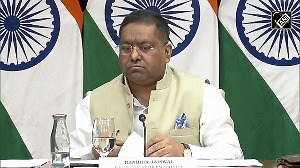By cutting the rate at which it lends to commercial banks, the Reserve Bank of India has decisively signalled that it has moved from targeting inflation to promoting growth rate, and further cuts in interest rates are expected, economists said on Tuesday.
RBI cut the repo rate - the rate at which the central bank lends to banks in exchange for government securities for a period ranging from one to three days - by one percentage point after a gap of four years.
This move was preceded by RBI reducing the cash reserve ratio - the money that banks keep with central bank - by 250 basis points (one basis point is one-hundredth of a percentage point).
"It's a clear signal from RBI that it has moved from inflation to growth priority," said Subir Gokarn, an economist with Standard & Poor's.
Though the latest Wholesale Price Inflation rate is 11.44 per cent, above the RBI's comfortable rate of 5 per cent, Prime Minister Dr Manmohan Singh told Parliament on Tuesday, "The movement in the level of prices show a clear deceleration in the current momentum of inflation. We expect a further reduction in the wholesale price index in the next two months".
Gokarn said RBI would now be expected to reduce the repo rate till the central bank gets a response in terms of growth numbers.
Describing the magnitude and timing of the repo rate cut as ahead of market expectations, Tushar Poddar, vice president, Asia Economics Research, Goldman Sachs, said, "We were expecting 150 basis points easing by the first quarter of 2009.
"With this move, the repo cuts may be of a larger magnitude, and we will be reviewing our rate views."
According to Goldman Sachs, transactions in the repo window are now around $7.8 billion as against a peak of over $16 billion.
As banks are depending less on repo for meeting their requirements, economists are also questioning whether the rate cut would be effective in reducing interest rate on lending by banks.
Rajeev Malik of Macquarie Economics Research said, "We also maintain a belief that the central bank will have to cut SLR by 2-3 percentage points, though this action will probably be unveiled in April 2009 when the policy for the next financial year will be announced."
SLR or statutory liquidity ratio is the amount banks invest in government securities, expressed as a percentage of the bank's demand liabilities.
As for what RBI will say in its forthcoming credit policy announcement, Gokarn said the central bank should explain why it cut the repo rate by a large magnitude, as people tend to become nervous when something dramatic is undertaken.








 © 2025
© 2025